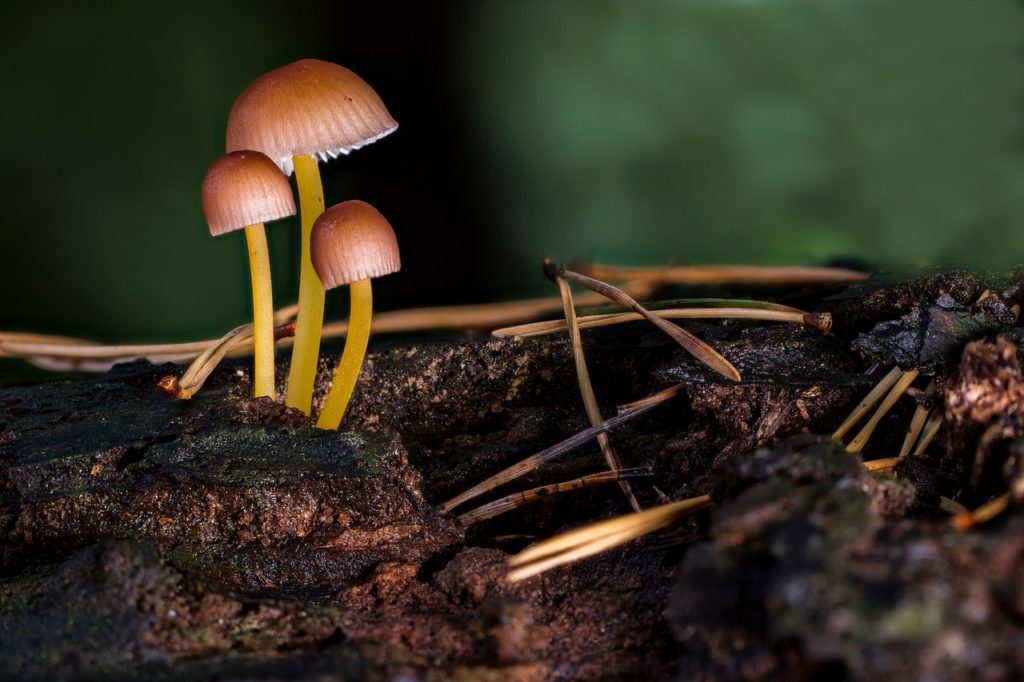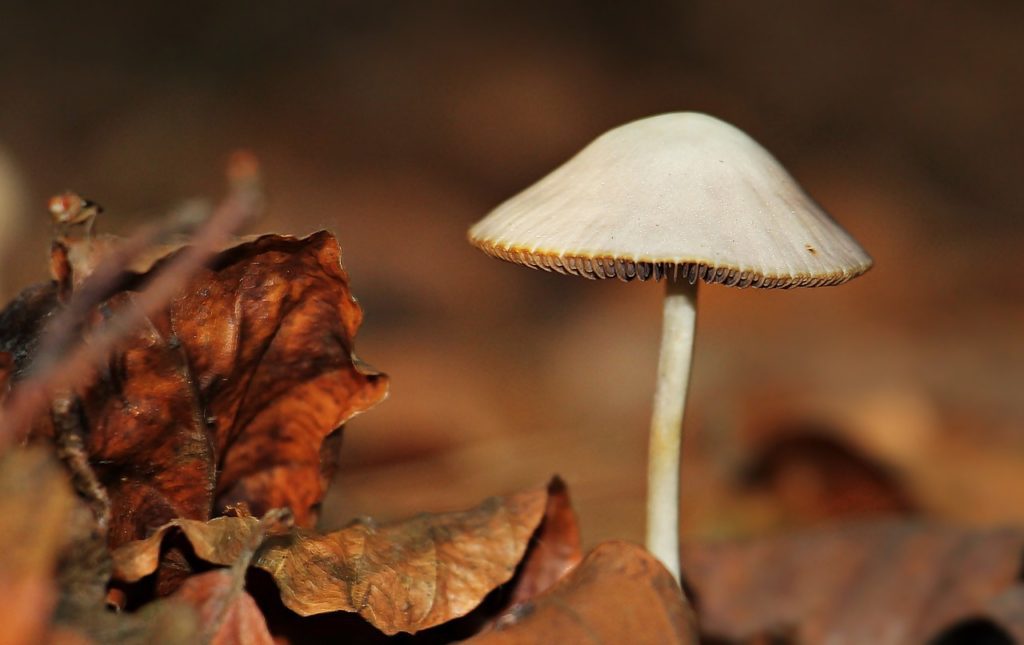Mulch fungus can grow on bark, sugar cane, straw and tree mulch and can range in color from white, orange, brown, red or pink. Fungus can be in the form of slime, mushrooms, toadstools or a range of other shapes including those that look like birds nests. Fungus will not harm your plants but larger growths are best to remove as they can look ugly and it can prevent dogs or kids eating it.
Types of fungus on mulch
Slime mold or dog vomit
This is a mold which forms into a lumpy pile that can look like vomit. It forms when conditions are damp and bacteria move in to break down the mulch. Fungus feed on the bacteria in the mulch that grows and forms the mold that you see on the surface.
Slime mold is likely to grow in shady areas where the mulch stays damp for longer but it can grow anywhere on your mulch. The mold can form in a range of colors from white, orange, red brown or pink.
Slime mold is not harmful to plants and if left to dry out will break down over time. If you have large areas of slime mold, remove it with shovel and place it in the bin.

Mushrooms & Toadstools
Mushrooms and toadstools are common fungi that can grow in mulch. The spores of the mushroom can travel from other areas by the wind or can already be in your mulch. Under the right conditions the mushroom spores can sprout and grow.

Toadstools can be poisonous so you should not eat anything that looks like a mushroom or toadstool that grows in your mulch. These small mushroom shaped fungi can often be colorful and they will develop this color to warm off predators. It is best to remove them so that children or pets do not eat them.
Birds nest fungus
Birds nest fungus might be the cutest fungus you will see and they look like tiny birds nests with eggs. They are only small, around ¼ of an inch so you might miss them but they are adorable.
Birds nest fungi are not a problem to plants and can be left on the mulch to eventually break down and return into the soil or removed and placed in the bin.
Artillery fungus
Artillery fungus look similar to a birds nest fungus with a tiny cup but only 1 small, black egg. These won’t cause any problems if they grow on your mulch but they can spread to the sides of houses and cars through the wind. On white surfaces they can leave a dark, black mark so remove them from your mulch if it is near your house, shed or car.
Fungus treatment for mulch
The best way to treat fungus in organic mulch is to remove it with a small shovel or spade. You will need to put the area of fungus and mulch removed in the bin and not your compost otherwise the spores can spread and re-grow.
Raking small patches of mulch off of the surface is an easy way to remove the mold. It won’t cause harm to your plants but they can look unpleasant so remove them to tidy up your garden.
You can let fungus dry out over time and it will break up and disappear. Larger fungus growths like mushrooms will need to be removed completely to remove the spores. It is a great idea to remove these if you have kids or dogs around.
There is no need to use fungicides on mulch mold as they are not harmful to plants and are easily removed. Avoid adding unnecessary chemicals to your garden and treat mold naturally.
Is mulch fungus harmful to plants?
Mulch fungus is not harmful to plants and forms through a natural process where the fungus feed on bacteria breaking down the mulch. In backyards it can look ugly so you can remove it with a spade and scoop it into the bin.
Remove an area of mulch a few inches around the mold to pick up as many spores as possible. This will help to prevent the mold from returning.
Cover the area in new mulch and avoid overwatering . Mold will thrive in damp conditions, similar to the lower levels of rainforests so keep the area dry to avoid the mold re-growing.
Types of mulch that can form fungus
Mulch types such as bark mulch, tree mulch, sugar cane and straw can all form mold or fungus if they are kept too damp or are in the shade. Mulch is an organic material that will be broken down through a natural composting process by the bacteria that live in your soil.

Fungus will come to eat the bacteria breaking down these natural mulch types and can form clusters that you can see. While the soil bacteria are too small for us to see, fungus can grow large enough to stand out as patches or mushrooms on the surface of our mulch.
I have had mold and fungus grow on my tree bark mulch and sugar cane but these only occurred in the shadiest areas of my garden.
Preventing fungus growth on mulch
The best way to prevent mold on mulch is to avoid extra water sitting on top of your mulch. Do this by watering in the morning close to the roots of the plant instead of overhead. Avoid putting excess moisture on top of the mulch.
Give your plants a deep watering less often at ground level and allow the mulch to dry out between watering. The more sunlight your mulch gets the less likely it is to grow mold.
Time of year that fungus will grow on mulch
Mulch will grow best in the months that get the most rain. Warmth, humidity and moisture are key to encouraging mold and fungus growth. Avoid adding extra water to the surface of your mulch in the rainy months to avoid mold.
Use a rake to move mulch around to disturb the fungus spores and stop them from growing in large patches. This will also help to dry the mulch out quicker and add more air flow which can prevent mold.
Mulch fungus and pets
It is best to remove large patches of mulch mold to avoid your pets accidentally eating it. Most dogs won’t be attracted to mold but larger mushrooms and toadstools could be harmful. For the safest option, remove large mold growths and cover the area with new, fresh mulch.
Mulch Fungus: Summary
Fungus growing on mulch is a natural process and can be very interesting to watch. There are lots of different types of fungus and molds that form on your mulch which will not harm your plants. The best way to prevent fungus is to keep your mulch surface dry by avoiding surface watering with hoses or sprinklers.
I am an accredited practicing dietitian, experienced gardener and a dedicated cook. I love writing and sharing my experience so you can learn from my successes and mistakes.

Comments are closed.